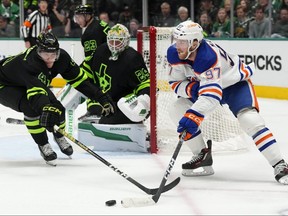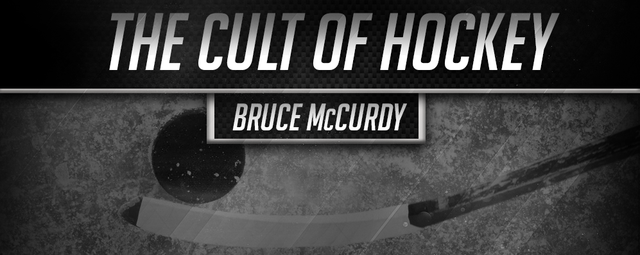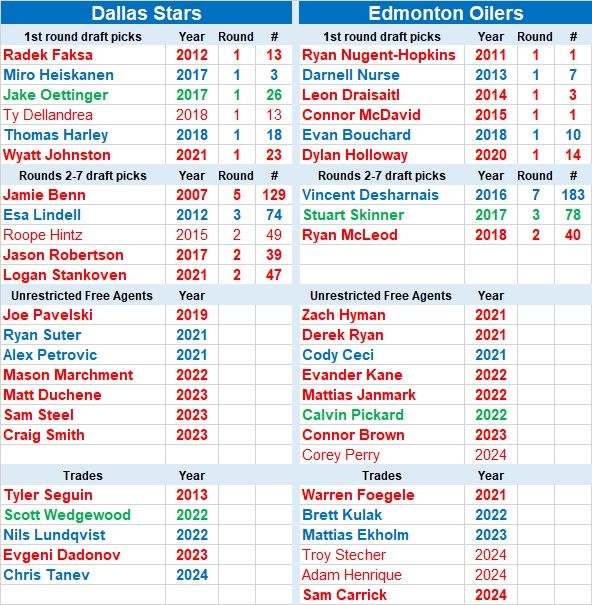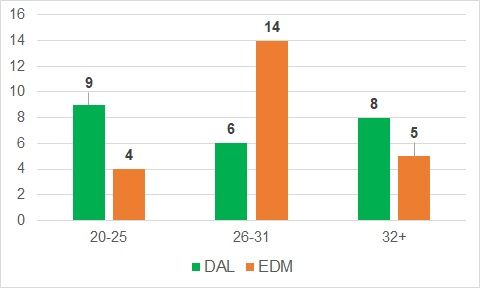
Article content
Two weeks and one very difficult seven-game series later, the Edmonton Oilers have vanquished the Vancouver Canucks and emerged as sole survivor of both the Pacific Division and of Canada. In the process they have qualified for the Western Conference Finals where they will meet up with an old, indeed historic nemesis, the Dallas Stars.
The Stars didn’t exactly take a shortcut to the WCF, having defeated the last two Stanley Cup champions to get here. Namely the Vegas Golden Knights and Colorado Avalanche, each of whom eliminated the Oilers enroute to the title in 2023 and 2022 respectively. So in one sense Dallas did the Oilers a favour, even as their dreaded green and black colours present something of a nightmare of historic proportions. Many an Oilers fan lived through the turn of the century, when the Stars eliminated the Oilers five playoff years in a row, 1998-2001 and 2003.
Advertisement 2
Article content
Article content
That said, names like Mike Modano, Sergei Zubov, Derian Hatcher and Ed Belfour live in the history books these days, whereas guys like Nathan MacKinnon, Cale Makar, Jack Eichel and Jonathan Marchessault are all going strong after leaving fresh wounds in the psyches of Oil fans. So bring on the Stars, I say.
It is of course a completely different bunch than those tormentors of the past. The modern group was largely assembled by GM Jim Nill, who has been at the helm for 11+ years after serving as Ken Holland’s right-hand man in Detroit for a decade and a half before that.
Let’s take a deeper look at how the modern Stars were built, and how they compare to the Oilers. We’ll use the same methodology that we revived for a recent analysis of the Canucks.
Forwards are shown in red font, defencemen in blue, goalies in green. The 20 players who actually dressed for the clubs’ most recent game are emphasized in bold font.
First round draft picks
Both teams have been heavily reliant on the NHL Draft. with each squad currently boasting six players they initially picked in the first round. The Stars list is impressive to be sure, but surely it is the Oilers who have the edge in quality here. Easily explained too: no fewer than five of those six Oiler were picked in the top 10 of their draft class, including a pair of aces at #1 overall. Indeed, the Edmonton side of this table features the top four scorers in the current playoffs!
Article content
Advertisement 3
Article content
The Stars had no decade of darkness. Indeed their worst points percentage during the salary cap era was a decent .482 in 2016-17, whereas the Oilers had 10 seasons since 2005 at or below that number. It follows that Dallas have have just one top 10 draft pick in their current squad, albeit a formidable one in defenceman Miro Heiskanen after winning the third-pick lottery in 2017. They followed up that selection of a franchise defenceman by picking a stud goalie in Jake Oettinger later in that round. In subsequent years they snagged another top-notch defender in Thomas Harley, and a crackerjack young forward in Wyatt Johnston with picks in the back half of the first round.
Rounds 2-7
This category sets the Stars apart, not just from the Oilers but from much of the NHL. They have established a history of picking outstanding players in deeper rounds. The first four players of this group are core players for the modern Stars, while Logan Stankoven, selected one round after Johnston in 2021, is starting to find his way as well.
Of particular note is Jason Robertson, a second round pick from 2017 who has subsequently averaged over a point per game in the NHL. That completed a natural hat trick of franchise d-man, #1 goalie and cornerstone forward in a single draft, all within the first 40 picks. Not sure it quite rivals Edmonton’s selection of three Hall of Famers (Kevin Lowe, Mark Messier, Glenn Anderson) with their first three picks in their first-ever NHL draft in 1979, but the Dallas trifecta of 2017 is surely on the short list of best draft trios of all time.
Advertisement 4
Article content
Unfortunately for Dallas, two-way centre Roope Hintz got hurt late in the Colorado series and has been declared out for Game One vs. Edmonton. His status for later in the series remains a mystery.
Unrestricted free agents
The Stars acquired a few solid veterans by the free agent route, with Joe Pavelski, Ryan Suter and Matt Duchene foremost among them. Among them they have played over 3800 NHL games! Top 6 forward Mason Marchment was at the other end of the UFA gravy train, signing a four-year deal with the Stars just days after his 27th birthday and providing value with a strong season in 2023-24.
From the bargain bin side, a name familiar to Oilers fans is Alex Petrovic, a depth defenceman who played 9 games here in 2018-19. The Stars signed him to an NHL minimum deal in 2021, then did the same in 2022 and yet a thid time in 2023. This season he played his first NHL game in 5 seasons, then played another in Game 6 vs. Colorado. Highly likely the Edmonton native will see (limited) action against his hometown team in the days to come.
Another free agent with a local angle is Ardrossan’s own Sam Steel, a former first round pick of Anaheim Ducks who was a topnotch offensive player in junior. The Stars signed him at just $850,000 and have utilized him as a depth forward and first-unit penalty killer, an unexpected development for this particular player. In the postseason he leads all Dallas forwards in SHTOI with solid results.
Advertisement 5
Article content
Acquired via trade
Nill’s first impact move was the acquisition of Tyler Seguin in a celebrated trade with Boston Bruins. All these years later, both remain in the organization.
The other major acquisition on this list is far more recent. Shutdown d-man Chris Tanev was one of the plums of the 2024 trade deadline, and the Stars outbid other contenders including the Oilers to land the 34-year-old. He played a crucial role in matching up against the likes of Jack Eichel and Nathan MacKinnon in their first two series, and no doubt will get a steady diet of Connor McDavid and Leon Draisaitl in the one to come.
Summary
Each squad has relied on all three major methods of player acquisition. The Stars 23-man list consists of 11 draft picks, 7 free agents, and 5 trades; the Oilers 9, 8 and 6 respectively. The major difference being Edmonton’s reliance on top-10 draft picks, while the Stars have proven to be among the NHL’s best at finding significant players much later in the first round and on Day Two as well.
One another significant difference between the two clubs is the age distribution of the rosters. The Stars have significantly more young players than do the Oilers, with 5 players born in the 2000’s compared to just 1. Dallas also have significantly more older players, with 6 players born in the 1980’s compared to just 2. It follows that Edmonton has far more players with birth dates in the 1990’s, 20 vs. just 12.
Advertisement 6
Article content
Here’s another way to parse that, by age clusters (age as at Jan 31, as per hockey-reference.com):
One final item which some readers might find interesting, namely a similar comparison between these same two teams back in 2020. Just seven Stars remain from the crew that went all the way to the SCF playing in the Edmonton bubble; meanwhile the Oilers of the Ken Holland era have turned over their entire roster except their leadership group, all four of them high draft picks from 2011-15. Of course both teams had draft picks in the system at that time who have subsequently made an impact in the bigs but were not a factor at that specific point in time.
Which club has done the better job of assembling a contender for the 2024 Stanley Cup? That question is soon to be answered on the ice.
Recently at the Cult of Hockey

Article content









